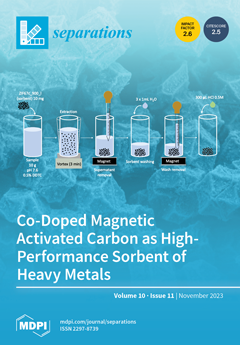Many high-altitude plants, such as
Hedyotis aspera, need to be explored for their possible medicinal value. The current study explored the protective effect of
Hedyotis aspera methanolic extract whole plant (HAME) against gentamicin-induced nephrotoxicity in rats. It profiled their phytocontents using HPLC-QTOF-MS/MS
[...] Read more.
Many high-altitude plants, such as
Hedyotis aspera, need to be explored for their possible medicinal value. The current study explored the protective effect of
Hedyotis aspera methanolic extract whole plant (HAME) against gentamicin-induced nephrotoxicity in rats. It profiled their phytocontents using HPLC-QTOF-MS/MS analytic methods. The LC-MS analysis of HAME revealed 27 compounds. Eight compounds followed Lipinski’s rule of five and were found to be potential TNF-α inhibitors with binding affinities of −6.9, −6.3, −6.3, and −6.3 Kcal/mol, such as 14,19-Dihydroaspidospermatine, coumeroic acid, lycocernuine and muzanzagenin. All potential compounds were found to be safe according to the ADMET analysis. The in vitro 2,2-diphenyl-1-picrlhydrazyl (DPPH) assay assessed the antioxidant activity. The nephroprotective activity was assessed in rats using a gentamicin-induced nephrotoxicity model. The in vivo analysis involved histological examination, tissue biochemical evaluation, including a kidney function test, catalase activity (CAT), reduced glutathione (GSH) levels, superoxide dismutase (SOD), and the inflammatory mediator TNF-α. Based on DPPH activity, HAME showed a scavenging activity IC
50 of 264.8 ± 1.2 µg/mL, while results were compared with a standard vitamin C IC
50 of 45 ± 0.45 µg/mL. Nephrotoxicity was successfully induced, as shown by elevated creatinine and uric acid levels, decreased kidney antioxidant levels, and increased TNF-α in gentamicin-treated rats. The HAME treatment significantly reduced serum creatinine and uric acid levels, increased GSH (
p < 0.01 **), CAT (
p < 0.01 **), and SOD (
p < 0.001 ***), and decreased TNF-α (
p < 0.001 ***) in nephrotoxic rats. The histopathological examination of the groups treated with HAME revealed a notable enhancement in the structural integrity of the kidneys as compared to the group exposed to gentamicin. Biochemical, histopathological, and phytochemical screening of HAME suggests that it has nephroprotective potential, owing to the presence of 14,19-Dihydroaspidospermatine, coumeroic acid, lycopene, and muzanzagenin.
Full article





